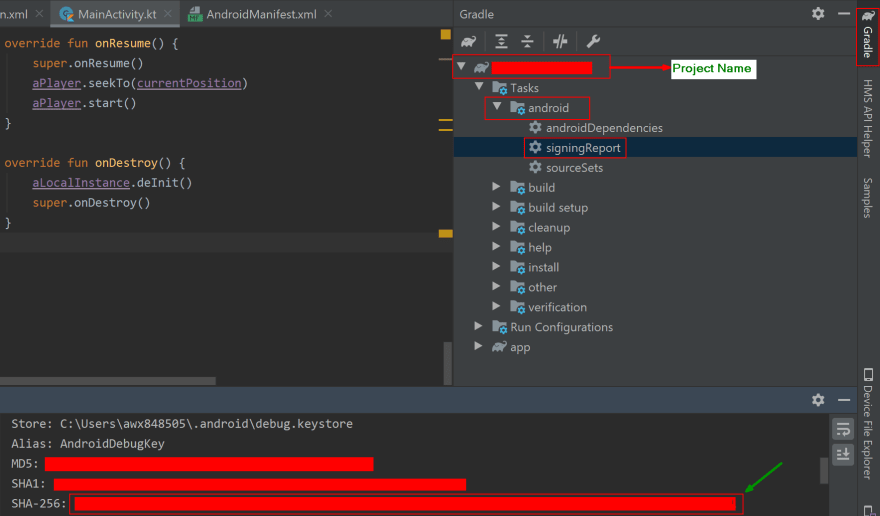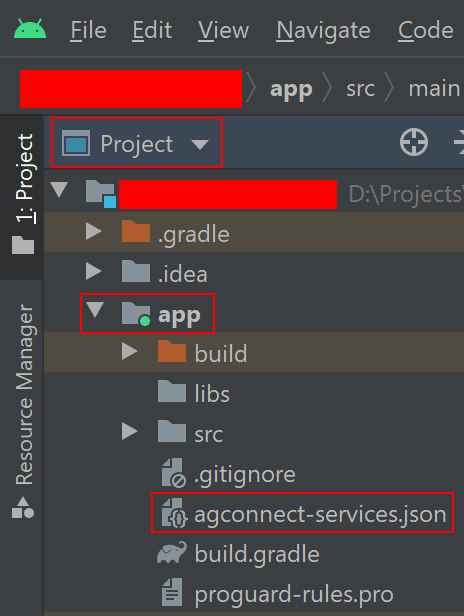
Introduction
In this article, we can learn how to integrate the Huawei Analytics Kit and Ads Kit in Money Management app along with that will display the Income and Expense list of the users. The main intention of this app is to track the daily spending's of the user. Based on this tracking, users can plan their spending's on daily, monthly or yearly basis.
So, I will provide the series of articles on this Money Management App, in upcoming articles I will integrate other Huawei Kits.
Analytics Kit
HUAWEI Analytics Kit provides analysis models to understand user behaviour and gain in-depth insights into users, products and content. It helps you to gain insight about user behaviour on different platforms based on the user behaviour events and user attributes reported by through apps.
AppGallery Connect
Find the Analytics using AppGallery connect dashboard.
Choose My Projects > Huawei Analytics > Overview > Project overview.
Project overview displays the core indicators of current project, such as the number of new users, User activity, User acquisition, User revisit, New user retention, Active user retention, User characteristics and Popular pages etc. providing a quick overview of the users and how they are using your app.
Ads Kit
Huawei Ads provides to developers a wide-ranging capabilities to deliver good quality ads content to users. This is the best way to reach target audience easily and can measure user productivity. It is very useful when we publish a free app and want to earn some money from it.
HMS Ads Kit has 7 types of Ads kits. Now we can implement Rewarded Ads in this application.
Rewarded ads are full-screen video ads that allow users to view in exchange for in-app rewards.
Requirements
- Any operating system (MacOS, Linux and Windows).
- Must have a Huawei phone with HMS 4.0.0.300 or later.
- Must have a laptop or desktop with Android Studio, Jdk 1.8, SDK platform 26 and Gradle 4.6 and above installed.
- Minimum API Level 24 is required.
- Required EMUI 9.0.0 and later version devices.
How to integrate HMS Dependencies
- First register as Huawei developer and complete identity verification in Huawei developers website, refer to register a Huawei ID.
- Create a project in android studio, refer Creating an Android Studio Project.
- Generate a SHA-256 certificate fingerprint.
- To generate SHA-256 certificate fingerprint. On right-upper corner of android project click Gradle, choose Project Name > Tasks > android, and then click signingReport, as follows.

Note: Project Name depends on the user created name.
- Create an App in AppGallery Connect.
- Download the agconnect-services.json file from App information, copy and paste in android Project under app directory, as follows.

- Enter SHA-256 certificate fingerprint and click Save button, as follows.

Note: Above steps from Step 1 to 7 is common for all Huawei Kits.
- Click Manage APIs tab and enable HUAWEI Analytics.

- Add the below maven URL in build.gradle(Project) file under the repositories of buildscript, dependencies and allprojects, refer Add Configuration.
maven { url 'http://developer.huawei.com/repo/' }
classpath 'com.huawei.agconnect:agcp:1.6.0.300'
- Add the below plugin and dependencies in build.gradle(Module) file.
apply plugin: id 'com.huawei.agconnect'
// Huawei AGC
implementation 'com.huawei.agconnect:agconnect-core:1.6.0.300'
// // Huawei Analytics Kit
implementation 'com.huawei.hms:hianalytics:6.4.0.300'
// Huawei Ads Kit
implementation 'com.huawei.hms:ads-lite:13.4.51.300'301'
// Recycler View
implementation 'androidx.recyclerview:recyclerview:1.2.1'
- Now Sync the gradle.
- Add the required permission to the AndroidManifest.xml file.
// Analytics Kit
<uses-permission android:name="android.permission.INTERNET" />
<uses-permission android:name="com.huawei.appmarket.service.commondata.permission.GET_COMMON_DATA" />
Let us move to development
I have created a project on Android studio with empty activity let us start coding.
In the MainActivity.kt we can find the business logic for Analytics.
class MainActivity : AppCompatActivity() {
// Initialize the Analytics
var mInstance: HiAnalyticsInstance? = null
override fun onCreate(savedInstanceState: Bundle?) {
super.onCreate(savedInstanceState)
setContentView(R.layout.activity_main)
btn_login.setOnClickListener(mOnClickListener)
// Initialize the Analytics function
initAna()
}
private fun initAna() {
// Enable Analytics Kit Log
HiAnalyticsTools.enableLog()
// Generate the Analytics Instance
mInstance = HiAnalytics.getInstance(this)
// Enable collection capability
mInstance?.setAnalyticsEnabled(true)
}
override fun onActivityResult(requestCode: Int, resultCode: Int, data: Intent?) {
super.onActivityResult(requestCode, resultCode, data)
if (requestCode == 1002 ) {
val authAccountTask = AccountAuthManager.parseAuthResultFromIntent(data)
if (authAccountTask.isSuccessful) {
// Analytics data to send custom events
val bundle = Bundle()
bundle.putString("email", data!!.extras!!.getString("email" ))
bundle.putString("name", data.extras!!.getString("name"))
bundle.putString("phone", data!!.extras!!.getInt("phone").toString())
bundle.putString("marks", data!!.extras!!.getFloat("86.5").toString())
mInstance!!.onEvent(HAEventType.SIGNIN, bundle)
Toast.makeText(this, "SigIn success", Toast.LENGTH_LONG).show()
} else {
Toast.makeText(this, "SignIn failed: " + (authAccountTask.exception as ApiException).statusCode, Toast.LENGTH_LONG).show()
}
}
}
}
In the Home.kt we can find the business logic for Rewarded Ads.
class Home : AppCompatActivity() {
private var rewardedAd: RewardAd? = null
@SuppressLint("SetTextI18n")
override fun onCreate(savedInstanceState: Bundle?) {
super.onCreate(savedInstanceState)
setContentView(R.layout.activity_home)
btn_income.setOnClickListener {
rewardAdShow()
}
btn_expense.setOnClickListener {
val intent = Intent(this, ExpenseActivity::class.java)
startActivity(intent)
}
loadRewardAd()
}
private fun navigateToScreen(){
val intent = Intent(this, IncomeActivity::class.java)
startActivity(intent)
}
// Load a rewarded ad
private fun loadRewardAd() {
if (rewardedAd == null) {
rewardedAd = RewardAd(this, "testx9dtjwj8hp")
}
val rewardAdLoadListener: RewardAdLoadListener = object : RewardAdLoadListener() {
override fun onRewardedLoaded() {
showToast("onRewardedLoaded")
}
override fun onRewardAdFailedToLoad(errorCode: Int) {
navigateToScreen()
showToast("onRewardAdFailedToLoad errorCode is :$errorCode")
}
}
rewardedAd!!.loadAd(AdParam.Builder().build(), rewardAdLoadListener)
}
// Display a rewarded ad
private fun rewardAdShow() {
if (rewardedAd!!.isLoaded) {
rewardedAd!!.show(this, object : RewardAdStatusListener() {
override fun onRewardAdOpened() {
showToast("onReward Ad Opened")
}
override fun onRewardAdFailedToShow(errorCode: Int) {
showToast("onReward AdFailed ToShow errorCode is :$errorCode")
navigateToScreen()
}
override fun onRewardAdClosed() {
showToast("onReward Ad Closed")
navigateToScreen()
loadRewardAd()
}
override fun onRewarded(reward: Reward) {
loadRewardAd()
}
})
}
}
private fun showToast(text: String) {
runOnUiThread {
Toast.makeText(this, text, Toast.LENGTH_SHORT).show()
}
}
}
In the IncomeActivity.kt we can find the business logic for Recycler View of Income List.
class IncomeActivity : AppCompatActivity() {
override fun onCreate(savedInstanceState: Bundle?) {
super.onCreate(savedInstanceState)
setContentView(R.layout.activity_income)
val recyclerView = income_recycler_view
val adapter = IncomeAdapter(this)
recyclerView.adapter = adapter
recyclerView.layoutManager = LinearLayoutManager(this)
}
}
Create the IncomeAdapter.kt adapter class to hold the Income list.
class IncomeAdapter internal constructor (context: Context): RecyclerView.Adapter<IncomeAdapter.ViewHolder>(){
private val inflater: LayoutInflater = LayoutInflater.from(context)
private var prices = arrayOf(" +5000", " +1000", " +500", " +900", " +10000", " +700", " +4000", " +850")
private var images = intArrayOf(R.drawable.bank_deposit, R.drawable.crypto, R.drawable.mutual, R.drawable.post,
R.drawable.rainday, R.drawable.real, R.drawable.retirement_plan, R.drawable.stock)
override fun onCreateViewHolder(parent: ViewGroup, viewType: Int): IncomeAdapter.ViewHolder {
val itemView = inflater.inflate(R.layout.income_list, parent, false)
return IncomeAdapter.ViewHolder(itemView)
}
override fun onBindViewHolder(holder: IncomeAdapter.ViewHolder, position: Int) {
holder.itemPrice.text = prices[position]
holder.itemImage.setImageResource(images[position])
}
override fun getItemCount(): Int {
return prices.size
}
class ViewHolder(ItemView: View) : RecyclerView.ViewHolder(ItemView) {
var itemPrice: TextView = itemView.findViewById(R.id.amount)
var itemImage: ImageView = itemView.findViewById(R.id.images)
}
}
In the ExpenseActivity.kt we can find the business logic for Recycler View of Expense List.
class ExpenseActivity : AppCompatActivity() {
override fun onCreate(savedInstanceState: Bundle?) {
super.onCreate(savedInstanceState)
setContentView(R.layout.activity_expense)
val recyclerView = expense_recycler_view
val adapter = ExpenseAdapter(this)
recyclerView.adapter = adapter
recyclerView.layoutManager = LinearLayoutManager(this)
}
}
Create the ExpenseAdapter.kt adapter class to hold the Expense list.
class ExpenseAdapter internal constructor (context: Context): RecyclerView.Adapter<ExpenseAdapter.ExpenseViewHolder>() {
private val inflater: LayoutInflater = LayoutInflater.from(context)
private var expenseprices = arrayOf(" -1000", " -2000", " -1500", " -500", " -2000", " -7000", " -2500", " -6500")
private var expenseimages = intArrayOf(R.drawable.clothes, R.drawable.food, R.drawable.grocery, R.drawable.icecream,
R.drawable.movie, R.drawable.resorts, R.drawable.shooping, R.drawable.trip)
override fun onCreateViewHolder(parent: ViewGroup, viewType: Int): ExpenseAdapter.ExpenseViewHolder {
val itemView = inflater.inflate(R.layout.expense_list, parent, false)
return ExpenseAdapter.ExpenseViewHolder(itemView)
}
override fun onBindViewHolder(holder: ExpenseAdapter.ExpenseViewHolder, position: Int) {
holder.expensePrice.text = expenseprices[position]
holder.expenseImage.setImageResource(expenseimages[position])
}
override fun getItemCount(): Int {
return expenseprices.size
}
class ExpenseViewHolder(ItemView: View) : RecyclerView.ViewHolder(ItemView) {
var expensePrice: TextView = itemView.findViewById(R.id.expense_amount)
var expenseImage: ImageView = itemView.findViewById(R.id.expense_images)
}
}
In the activity_home.xml we can create the UI screen for buttons.
<?xml version="1.0" encoding="utf-8"?>
<LinearLayout xmlns:android="http://schemas.android.com/apk/res/android"
xmlns:app="http://schemas.android.com/apk/res-auto"
xmlns:tools="http://schemas.android.com/tools"
android:layout_width="match_parent"
android:layout_height="match_parent"
android:orientation="vertical"
android:paddingTop="10dp"
android:paddingBottom="10dp"
tools:context=".Home">
<Button
android:id="@+id/btn_income"
android:layout_width="220dp"
android:layout_height="wrap_content"
android:layout_marginTop="70dp"
android:textAlignment="center"
android:layout_gravity="center_horizontal"
android:textSize="20sp"
android:textColor="@color/dot_dark_screen3"
android:padding="10dp"
android:textAllCaps="false"
android:text="Income" />
<Button
android:id="@+id/btn_expense"
android:layout_width="220dp"
android:layout_height="wrap_content"
android:layout_marginTop="50dp"
android:textAlignment="center"
android:layout_gravity="center_horizontal"
android:textSize="20sp"
android:textColor="@color/dot_dark_screen4"
android:padding="8dp"
android:textAllCaps="false"
android:text="Expenses" />
<Button
android:id="@+id/btn_trans"
android:layout_width="220dp"
android:layout_height="wrap_content"
android:layout_marginTop="50dp"
android:textAlignment="center"
android:layout_gravity="center_horizontal"
android:textSize="20sp"
android:textColor="@color/dot_dark_screen5"
android:padding="8dp"
android:textAllCaps="false"
android:text="Transactions" />
</LinearLayout>
In the activity_income.xml we can create the UI screen Recycler Items.
<?xml version="1.0" encoding="utf-8"?>
<LinearLayout xmlns:android="http://schemas.android.com/apk/res/android"
xmlns:app="http://schemas.android.com/apk/res-auto"
xmlns:tools="http://schemas.android.com/tools"
android:layout_width="match_parent"
android:layout_height="match_parent"
android:gravity="center_vertical"
android:orientation="vertical"
android:paddingLeft="8dp"
android:paddingRight="8dp"
tools:context=".IncomeActivity">
<TextView
android:layout_width="wrap_content"
android:layout_height="wrap_content"
android:layout_marginTop="28dp"
android:layout_gravity="center_horizontal"
android:text="Income"
android:textStyle="bold"
android:textColor="#025022"
android:layout_marginBottom="20dp"
android:textSize="30sp"/>
<androidx.recyclerview.widget.RecyclerView
android:id="@+id/income_recycler_view"
android:layout_width="match_parent"
android:layout_height="match_parent" />
</LinearLayout>
In the activity_expense.xml we can create the UI screen Recycler Items.
<?xml version="1.0" encoding="utf-8"?>
<LinearLayout xmlns:android="http://schemas.android.com/apk/res/android"
xmlns:app="http://schemas.android.com/apk/res-auto"
xmlns:tools="http://schemas.android.com/tools"
android:layout_width="match_parent"
android:layout_height="match_parent"
android:gravity="center_vertical"
android:orientation="vertical"
android:paddingLeft="8dp"
android:paddingRight="8dp"
tools:context=".ExpenseActivity">
<TextView
android:layout_width="wrap_content"
android:layout_height="wrap_content"
android:layout_marginTop="28dp"
android:layout_gravity="center_horizontal"
android:text="Expenses"
android:textStyle="bold"
android:textColor="#F1066F"
android:layout_marginBottom="20dp"
android:textSize="30sp"/>
<androidx.recyclerview.widget.RecyclerView
android:id="@+id/expense_recycler_view"
android:layout_width="match_parent"
android:layout_height="match_parent" />
</LinearLayout>
In the income_list.xml we can create the custom view of Recycler UI Items.
<?xml version="1.0" encoding="utf-8"?>
<androidx.cardview.widget.CardView xmlns:android="http://schemas.android.com/apk/res/android"
xmlns:app="http://schemas.android.com/apk/res-auto"
android:layout_width="match_parent"
android:layout_height="wrap_content"
android:layout_marginLeft="-3dp"
android:layout_marginTop="5dp"
android:layout_marginRight="0dp"
android:layout_marginBottom="5dp">
<LinearLayout
android:layout_width="match_parent"
android:layout_height="100dp"
android:orientation="horizontal">
<ImageView
android:id="@+id/images"
android:layout_width="130dp"
android:layout_height="80dp"
android:layout_gravity="left"
android:layout_marginStart="0dp"
android:layout_marginLeft="0dp" />
<TextView
android:id="@+id/amount"
android:layout_width="wrap_content"
android:layout_height="80dp"
android:layout_marginLeft="45dp"
android:text="Item"
android:textSize="36sp"
android:layout_gravity="end"
android:textAlignment="viewEnd"
android:textColor="@android:color/holo_green_light"
android:textStyle="bold" />
</LinearLayout>
</androidx.cardview.widget.CardView>
In the expense_list.xml we can create the custom view of Recycler UI Items.
<?xml version="1.0" encoding="utf-8"?>
<androidx.cardview.widget.CardView xmlns:android="http://schemas.android.com/apk/res/android"
xmlns:app="http://schemas.android.com/apk/res-auto"
android:layout_width="match_parent"
android:layout_height="wrap_content"
android:layout_marginLeft="-3dp"
android:layout_marginTop="5dp"
android:layout_marginRight="0dp"
android:layout_marginBottom="5dp">
<LinearLayout
android:layout_width="match_parent"
android:layout_height="100dp"
android:orientation="horizontal">
<ImageView
android:id="@+id/expense_images"
android:layout_width="130dp"
android:layout_height="80dp"
android:layout_gravity="left"
android:layout_marginStart="0dp"
android:layout_marginLeft="0dp" />
<TextView
android:id="@+id/expense_amount"
android:layout_width="wrap_content"
android:layout_height="80dp"
android:layout_marginLeft="45dp"
android:text="Item"
android:textSize="36sp"
android:layout_gravity="end"
android:textAlignment="viewEnd"
android:textColor="@color/purple_200"
android:textStyle="bold" />
</LinearLayout>
</androidx.cardview.widget.CardView>
Demo
Tips and Tricks
- Make sure you are already registered as Huawei developer.
- Set minSDK version to 24 or later, otherwise you will get AndriodManifest merge issue.
- Make sure you have added the agconnect-services.json file to app folder.
- Make sure you have added SHA-256 fingerprint without fail.
- Make sure all the dependencies are added properly.
Conclusion
In this article, we have learned how to integrate the Huawei Analytics Kit and Ads Kit in Money Management app along with that will display the Income and Expense list of the users. The main intention of this app is to track the daily spending's of the user. Based on this tracking, users can plan their spending's on daily, monthly or yearly basis. So, I will provide the series of articles on this Money Management App, in upcoming articles will integrate other Huawei Kits.
I hope you have read this article. If you found it is helpful, please provide likes and comments.
Reference
Analytics Kit – Documentation
Analytics Kit – Training Video
Ads Kit - Documentation
Ads Kit – Training Video







Top comments (0)